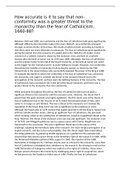How accurate is it to say that non-
conformity was a greater threat to the
monarchy than the fear of Catholicism,
1660-88?
Between 1660 and 1688, non-conformity and the fear of Catholicism both grew significantly.
Although stifled by the Clarendon Code in the years 1660-65, non-conformity emerged,
stronger as shown by the 1676 census, the results of which proved, according to Charles II,
that there were too many dissenters to persecute. The fear of Catholicism grew significantly
during the period, from the concerns of a papist plot in the 1666 Fire of London, to the
concerns of a Catholic monarch, shown by the exclusion crisis, and then of a Catholic
dynasty after the birth of James' son on 10th June 1688. Ultimately, the fear of Catholicism
was the primary factor for the fall of the Stuart monarchy, as the birth of James' son acted
as the trigger for the 'immortal seven' to invite William to invade. However, non-conformity
threatened the stability of monarchical rule during the period, as shown by the Fifth
Monarchists or the seven bishops who successfully opposed the power of the King in 1688.
To evaluate the extent to which non-conformity or the fear of Catholicism was a threat to
the monarchy, one ought to consider the threat to the monarch himself and to the
prerogatives of the monarch, as these were the defining features of the monarchy. The fear
of Catholicism had a conclusive role in the fall of the Stuart monarchy and hence was a
greater threat to the monarchy than non-conformity.
While prevalent throughout the period, the fear of Catholicism did not truly pose a
significant threat to the monarchy until the exclusion crisis. However, the threat that it
posed from this point onwards was highly significant. The first minor case of the threat of
fear of Catholicism was in the Test Act of 1673, which forced James Duke of York, later
James II, to resign as Lord Admiral. This was a threat to the monarchy as it harmed the
reputation of the future King, but it was not as significant as the problems to come.
Although the Popish plot of 1678 claimed that papists planned to kill the King to replace him
with his Catholic brother James, stirring up significant fear of Catholicism, the plot itself,
which certainly relied on the existing fear of Catholicism, posed an insignificant threat to the
King. However, the threat of the exclusion crisis was real and significant. The exclusion crisis
of 1679-81 saw Whiggish politicians aim to replace James with Charles' illegitimate son
Monmouth in the succession. This was a significant threat due to the nature of the
challenge, targeting the hereditary right of the monarch, the most integral prerogative of an
English monarch, and due to the real possibility, that this threat might have materialised.
The Whig politicians, by gathering 20,000 signatures on a petition for the exclusion bill,
showed that they posed a grave threat to the hereditary right of the monarch in 1680. While
the Monmouth Rebellion gathered little support in 1685, the rejection of the 1688
Declaration of Indulgence by 7 bishops may be seen as a threat to the monarchy, since their
fear of Catholicism outweighed their obedience to the monarch. By refusing to read out the
1688 Declaration of Indulgence which was explicit on the rights of Catholics, these seven
bishops posed a threat to the monarchy by challenging James' right to suspend law, which
he had proven by the Godden vs Hales case of 1686. Finally, the fear of Catholicism




